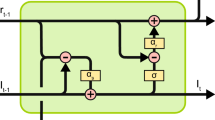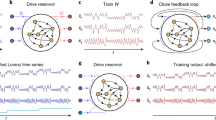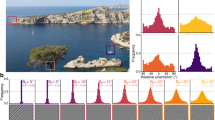Abstract
MOST models of neural networks have assumed that neurons process information on a timescale of milliseconds and that the long-term modification of synaptic strengths underlies learning and memory1. But neurons also have cellular mechanisms that operate on a timescale of tens or hundreds of milliseconds, such as a gradual rise in firing rate in response to injection of constant current2 or a rapid rise followed by a slower adaptation3. These dynamic properties of neuronal responses are mediated by ion channels that are subject to modulation4. We demonstrate here how a neural network with recurrent feedback connections can convert long-term modulation of neural responses that occur over these intermediate timescales into changes in the amplitude of the steady output from the system. This general principle may be relevant to many feedback systems in the brain. Here it is applied to the vestibulo–ocular reflex, whose amplitude is subject to long-term adaptive modification by visual inputs5. The model reconciles apparently contradictory data on the neural locus of the cellular mechanisms that mediate this simple form of learning and memory.
This is a preview of subscription content, access via your institution
Access options
Subscribe to this journal
Receive 51 print issues and online access
$199.00 per year
only $3.90 per issue
Buy this article
- Purchase on Springer Link
- Instant access to full article PDF
Prices may be subject to local taxes which are calculated during checkout
Similar content being viewed by others
References
Churchland, P. S. & Sejnowski, T. J. The Computational Brain (MIT Press, Cambridge, MA. 1992).
Storm, J. F. Nature 336, 379–381 (1988).
Bradley, K. & Somjen, G. G. J. Phystol., Lond. 156, 75–92 (1961).
Strong, J. A. & Kaczmarek, L. K. in Neuromodulation: The Biochemical Control of Neuronal Excitability (eds Kaczmarek, L. K. & Levitan, I. B.) (Oxford University Press, 1987).
Lisberger, S. G. Science 242, 728–735 (1988).
Miles, F. A., Braitman, D. J. & Dow, B. M. J. Neurophysiol. 43, 1477–1493 (1980).
Lisberger, S. G. & Pavelko, T. A. Science 242, 771–773 (1988).
Miles, F. A., Fuller, J. H., Braitman, D. J. & Dow, B. M. J. Neurophysiol. 43, 1437–1476 (1980).
Lisberger, S. G., Morris, E. J. & Tychsen, L. A. Rev. Neurosci. 10, 97–129 (1987).
Fuchs, A. F. & Kimm, J. J. Neurophysiol. 38, 1140–1161 (1975).
Gonshor, A. & Melvill Jones, G. J. Physiol., Lond. 256, 381–414 (1976).
Miles, F. A. & Lisberger, S. G. A. Rev. Neurosci. 4, 273–299 (1981).
Ito, M. Brain Res. 40, 81–84 (1972).
Watanabe, E. Brain Res. 297, 169–174 (1984).
Lisberger, S. G. & Sejnowski, T. J. Univ. California San Diego Inst. Neural Comput. Tech. Rep. 9201 (1992).
Lisberger, S. G. & Pavelko, T. A. J. Neurosci. 6, 346–354 (1986).
Author information
Authors and Affiliations
Rights and permissions
About this article
Cite this article
Lisberger, S., Sejnowski, T. Motor learning in a recurrent network model based on the vestibulo–ocular reflex. Nature 360, 159–161 (1992). https://doi.org/10.1038/360159a0
Received:
Accepted:
Issue Date:
DOI: https://doi.org/10.1038/360159a0
This article is cited by
-
Computational Theory Underlying Acute Vestibulo-ocular Reflex Motor Learning with Cerebellar Long-Term Depression and Long-Term Potentiation
The Cerebellum (2017)
-
Elimination of climbing fiber instructive signals during motor learning
Nature Neuroscience (2009)
-
A computational study of synaptic mechanisms of partial memory transfer in cerebellar vestibulo-ocular-reflex learning
Journal of Computational Neuroscience (2008)
-
Neural mechanism underlying the transsynaptic shift of memory trace in motor learning
The Cerebellum (2006)
-
Cerebellar AMPA/KA receptor antagonism by CNQX inhibits vestibuloocular reflex adaptation
Experimental Brain Research (2005)
Comments
By submitting a comment you agree to abide by our Terms and Community Guidelines. If you find something abusive or that does not comply with our terms or guidelines please flag it as inappropriate.



